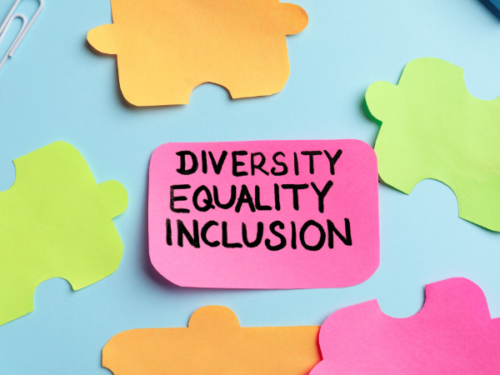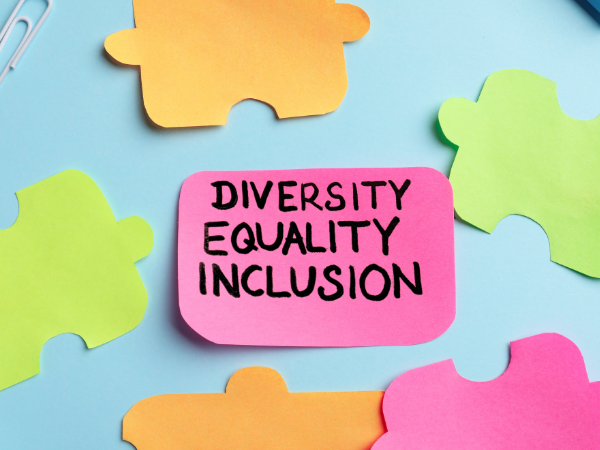
How to Break Down the Bias in AI and Embrace Inclusion

Keeping up to speed with digital transformation, creativity, and innovation goes hand in hand with creating an inclusive workplace that embraces diversity and ensures equal opportunities. Advances in artificial intelligence (AI) have been around long enough for businesses to recognise the value these tools have. They can go a long way into making routine tasks and complex jobs quicker to solve and more efficient to complete.
However, while they make lighter work of heavy-laden and time-consuming operations from a technical point of view—they bring with them a social responsibility. AI was created through a narrow lens that inherently perpetuates existing biases around gender, and undermines the importance of a diverse and inclusive workplace.
Although businesses will continue to benefit from embracing AI in 2025 and beyond, left unchecked, these negative, tech solutions can potentially cause more harm. This article explores how to embrace AI technology, addressing any bias blindspots, and deploy the tools to cancel out harmful stereotypes in the future.
Recognising the bias that exists in AI
Recognising that bias exists and understanding why it does is the first step towards breaking it down. AI systems are fundamentally shaped and flawed, or perfected, by the data they learn from. Machine learning bias mirrors (and perpetuates) human biases as AI systems learn from data that often contains these biases (as well as prompts). This bias then disrupts the fairness and accuracy of AI-driven decisions, results, and answers.
If an AI system learns mainly from data created by one demographic group, the resultant perspectives and opinions may not serve others as well. This is especially relevant within the tech industry, where there is already a lack of diversity. Women only make up around 29% of the sector and ethnic minorities just 22%. This lack of diversity weaves through AI models, which when adopted in business goes on to influence online searches, recruitment drives, and content creation.
Personalising AI prompters
The more varied the dataset used to train an AI model, the more nuanced and less biased that resulting model will be. The good news is that there is already a collective urgency that something does need to be done to correct AI bias in tech and mitigate against it happening in the future. Indeed, the European Parliament and EU AI Act has been created with an ‘Ethics of Artificial intelligence: Issues and Initiatives Report to regulate testing AI systems, and to implement risk mitigation measures to tackle discriminatory bias.
The overarching goal is to have a diverse AI set of tools that can be relied on by a range of businesses and personnel across varying sectors and industry settings. In turn, a wider and inclusive pool of creators and prompters, across different industries and various roles, can embrace and continue to experiment with the ongoing advances and challenges in AI tools.
Whether it’s marketing experts, photographers with digital cameras for filming, or healthcare specialists analysing medical data, diverse perspectives can be heard, valued, and integrated into the AI development process. In this way, it’s possible to create an environment where diversity in AI evolution can be valued and shared to improve technological solutions and create more empathetic, intelligent, and genuinely useful technologies. In doing so, the AI bias will dissolve to more largely reflect the complexity of human experience.
Likewise, personalising AI prompts may help to deliver tailored content, images, and products that are without bias. This can be achieved when creating online content via AI whether that’s e-newsletters, automated social media posts, and email campaigns. Personalised content can be extra relevant, informative and realistic to break down inherent bias.
Experimenting with technology to remove bias
Diverse representation in AI development isn’t just about fairness; it’s about knowing how to create intelligent, nuanced, and smarter solutions. It’s basically about learning how to outsmart the bias in AI tools, or programming the software (text and imagery) without the harmful parts that damage diversity. It is possible for a development tech professional or an internal team of people to reframe the perspective and alter AI systems to remove the bias.
The following offer proactive solutions for addressing potential bias blind spots:
- Language engineering: A technically diverse development team can systematically map and integrate nuanced communication contexts into AI systems. By intentionally building multilingual and cross-cultural understanding, tech teams can develop AI that interprets complex communication, nuanced expressions, and healthy communication styles.
- Recreating fair algorithms: Sophisticated technical teams can implement robust bias detection and mitigation strategies through advanced screening methodologies. By developing sophisticated algorithmic auditing processes, tech teams can create machine learning models with built-in fairness metrics, statistical validation protocols, and continuous bias monitoring mechanisms.
- Opening up accessibility in design and technological capabilities: Forward-thinking tech development approaches prioritise creating AI solutions that are inherently adaptable across different user capabilities, technological environments, and interaction modalities. This means engineering flexible systems that can dynamically adjust interfaces, comprehension levels, and interaction paradigms to support diverse user needs.
- Creating an ethical framework and a healthier ecosystem: Establish ethical assessment frameworks that go beyond surface-level compliance and align AI solutions with broader societal values. By creating collaborative structures that encourage knowledge exchange, and perspective-sharing, generate more adaptive, creative, and intelligent tech solutions.
The aim is to shift from a perspective of diversity as a passive strategy to an active, strategic approach. Instead of simply avoiding bias, the focus turns to building more intelligent, nuanced, and contextually aware AI systems with deliberate, sophisticated technological design and smarter human input.
Embracing diversity in AI development
Another way to address intentional or unintentional bias within any tech roles is to increase efforts to recruit more diversity across a tech workforce. This means having a diverse recruitment drive in tech and software development roles, i.e. including women, people of colour, those from different socioeconomic levels, anyone across the LGBTQ+ spectrum, people with disabilities, diverse cultures, religions, and geographic regions.
In summary, include:
- Recruiting to actively seek talent from underrepresented communities and support early-career professionals from diverse backgrounds
- Establishing inclusive workplace cultures that value different perspectives
- Developing ongoing training models focused on recognising and mitigating unconscious bias
- Supporting educational initiatives that introduce technical skills to historically marginalised communities
Together, uniting different voices, experiences, and perspectives will help to overcome recruitment bias. In this way, the future training data, algorithms, facts or figures feeding the AI models will become less harmful. In addition to responding to best practices in recruitment, look at partnering up with organisations to help expand any recruitment campaigns further, and promote them both at home and abroad to broaden the reach to a global, multi-cultural workforce.
Similarly, with diverse apprenticeship and internship schemes, market them and share recruitment drives across news channels and on social media platforms, to keep the momentum growing.
Reframing AI to address the bias isn’t just a moral imperative but it is an important step to enhance the quality, reliability, business reputation, and inclusiveness of AI technologies. While a difficult challenge, increasing diversity is essential for AI to provide fair and beneficial outcomes for everyone. As AI’s impact continues to expand into 2025 and beyond, the models defining the future need to represent the full spectrum of human perspectives and experiences.

Dakota Murphey
Dakota Murphey is an experienced freelance writer, who specialises in business and lifestyle topics ranging from digital trends to photography, sustainability and travel. She regularly contributes her insights and knowledge to a variety of digital publications.






















